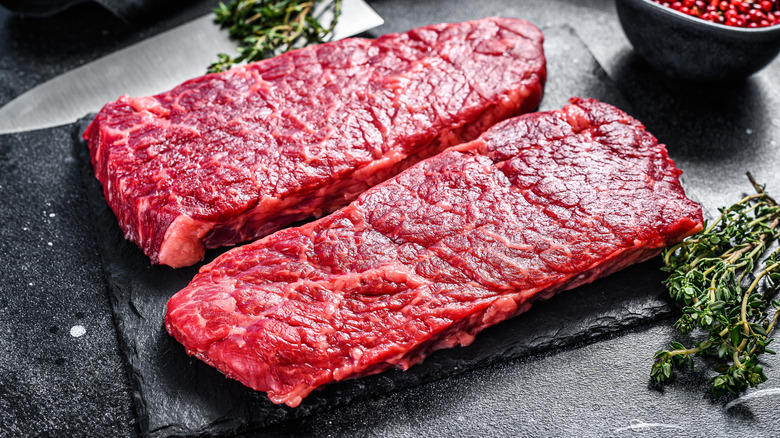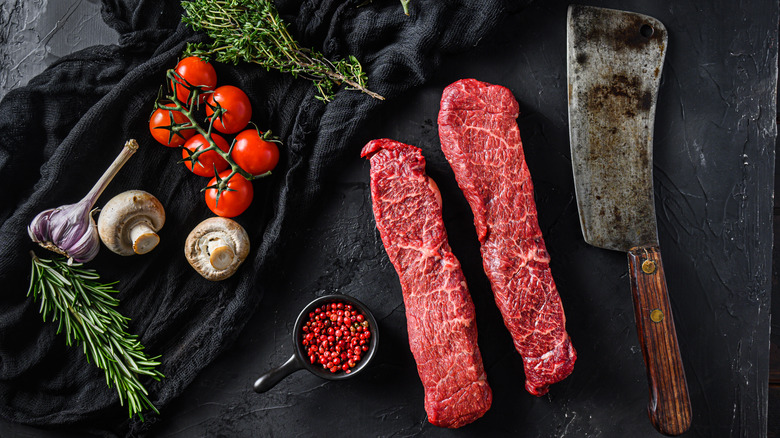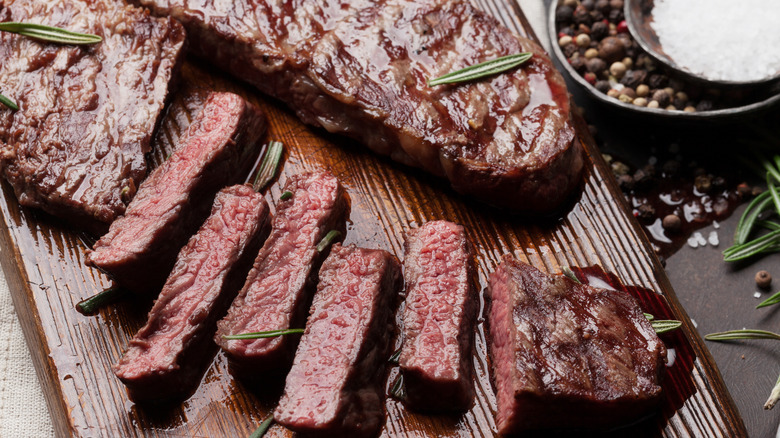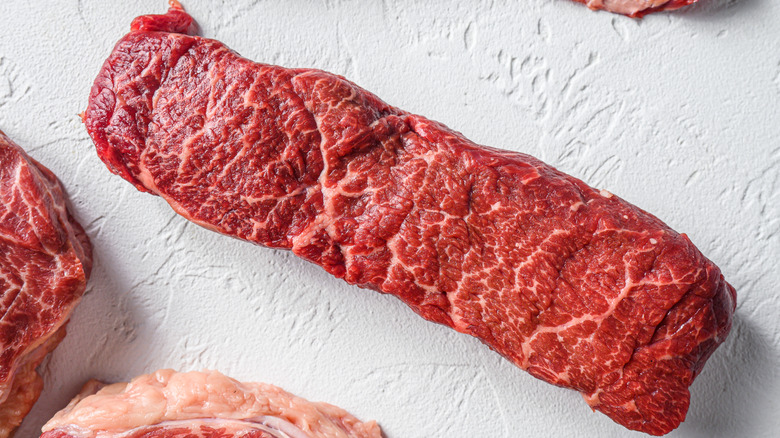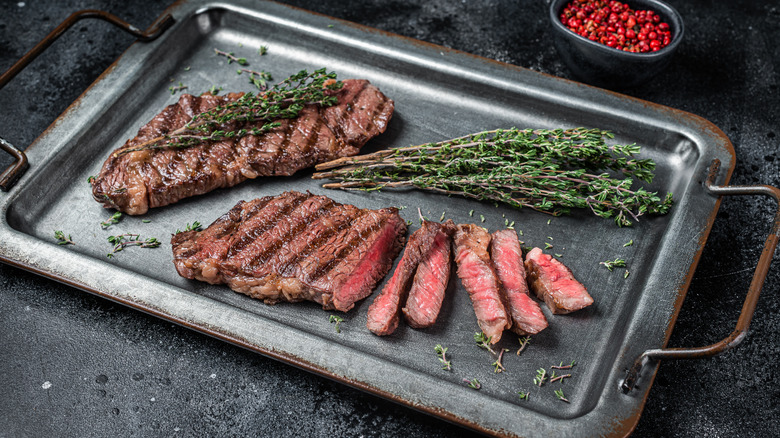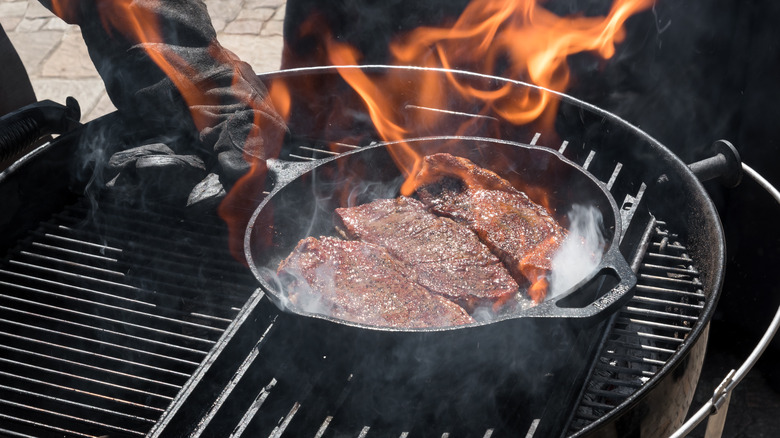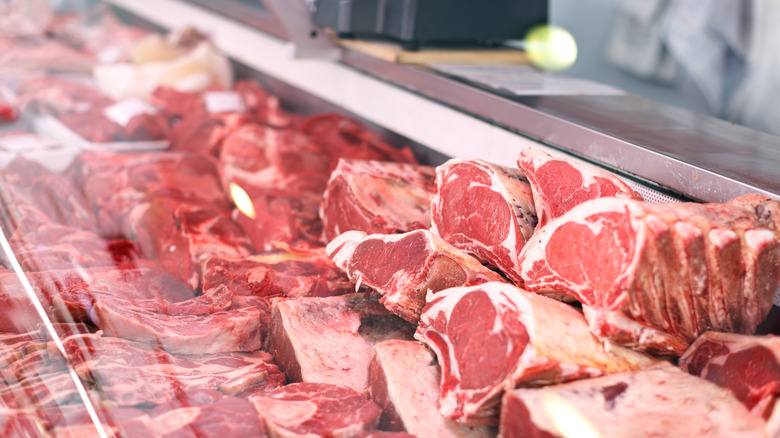What Is A Denver Steak And How Should You Cook It?
Humans have been eating beef since prehistoric times, so you'd think we'd have discovered every cut of steak a long time ago. But in the mid-2000s, the American beef industry was shaken up by a study that claimed to discover multiple new cuts of beef. This study, funded by the Beef Checkoff program (the same program that brought us "Beef. It's What's for Dinner"), took five years and $1.5 million to complete. Its goal was to increase American beef sales by finding new, affordable cuts of steak to market.
Researchers analyzed 39 different muscles in cattle, looking for ones they could isolate and slice just so to create the tenderest options possible. The cuts introduced by this research include the flat iron steak, petite tender, Sierra steak, and America's beef roast, but the study's most famous creation is arguably the Denver steak.
The Denver steak was identified by meat science professors (yes, apparently, that's a thing) at the University of Florida and the University of Nebraska, who were taking part in the Beef Checkoff study. It was introduced to the public in 2009, and the name "Denver" was chosen through focus group research. The National Cattlemen's Beef Association, a contractor to the Beef Checkoff program, is headquartered in the Denver area, but that is the extent of the connection between Denver steaks and their namesake city. Other names for this cut are chuck under blade steak, chuck under blade center steak, and Denver cut.
How is a Denver steak butchered?
Denver steaks are part of the chuck primal cut. The primals are the main cuts a butcher divides a cow carcass into before cutting out the individual steaks. There are eight primal cuts: The chuck, rib, loin, round, flank, plate, brisket, and shank. From which we get Denver steaks, the chuck is located around the cow's shoulders. Meat from this region is known for its exceptionally rich flavor.
Unfortunately, chuck tends to be chewy because the shoulder muscles must work a lot for the cow to walk and are bound with tough connective tissue. For these reasons, the chuck has historically been overlooked, mainly used for pot roasts and ground meat. One of the main goals of the Beef Checkoff study was to find tender portions of the chuck that could be separated from their tough surroundings, and that's precisely how we got the Denver steak.
The Denver steak is cut from the serratus ventralis muscle, which is tucked away beneath the cow's shoulder blade. Because of this positioning, the serratus ventralis is subject to far less stress than other muscles within the chuck primal, and it has better marbling. It's hard to appreciate this when the serratus ventralis is served as part of a larger chuck roll, but if you trim away all of the connective tissue surrounding it, you're left with quite the tender steak. However, this process is rather tedious and takes a highly skilled butcher to perfect.
Denver steak taste and texture
What makes the Denver steak so special is that it packs all of the rich, beefy flavor you get from chuck meat, but it isn't tough like most other chuck cuts. In fact, the Beef Checkoff study that first brought this cut to light identified the Denver steak as the fourth-most-tender piece of beef after the tenderloin, flat iron, and ribeye cap (curiously enough, the flat iron steak also comes from the chuck primal, revealing that two of the finest cuts of steak were hiding in plain sight all for ages).
There are two keys to the Denver steak's texture, one being the aforementioned fact that the muscle it comes from doesn't get much use. The other factor is the steak's marbling — the flecks of fat within the muscle itself. Unlike the thick fat found between muscles, which can become rubbery when cooked, marbling fat is exceptionally soft and melts into the meat as it cooks. This makes the steak juicer and more flavorful.
Is the Denver steak actually a new cut?
Despite its qualities, the Denver steak is controversial in the butchering community. The key point of contention is whether the Denver steak actually deserves its own classification and, more importantly, whether it's really as "new" as the Beef Checkoff program made it seem.
Some veteran butchers have criticized the hype around Denver steaks as a mere marketing ploy, saying it is simply a chuck steak with the gristle cut off. Moreover, butchers in other countries prepared this cut long before the Beef Checkoff program's research began. It is popular amongst Italian and French butchers, while in Japan, the steak is known as a Zabuton, meaning "cushion" or "pillow," and is a celebrated cut of the nation's famous Wagyu beef.
Another factor affecting the Denver steak's sense of legitimacy is that there are few regulations regarding naming beef cuts. Multiple names may refer to each cut, and more confusingly, the same name may be used for multiple cuts. Butchers and restaurants are not obligated to call the Denver steak a Denver steak, and they can assign the name elsewhere if they want. This can lead to confusion between different cuts, and with the Denver steak, there's one particular mix-up you don't want to make.
Denver steak versus Denver roast
Before you go shopping for Denver steaks, you need to know that there are two slightly different cuts of meat that both bear the name Denver. They both come from under the cow's shoulder blade, but while Denver steaks are the tender and marbled, rectangle-shaped cut of meat from the serratus ventralis muscle, Denver roasts come from both the serratus ventralis and the longissimus dorsi. The two muscles are connected, and a good amount of that connective tissue can be found on most Denver roasts.
While the Denver steak is noted for its tenderness, much of the muscle directly around it can be a bit tougher. Roasting is the recommended cooking method for the Denver roast, hence the name, though pressure cooking and braising are also suggested. It's trickier to cook them with more "open air" methods, such as on the grill or stovetop. Cooking a Denver roast in the same way you cook a Denver steak would give you a much tougher end product. Speaking of which, it's time we addressed the art of cooking this beautiful cut.
How to cook a Denver steak
A Denver steak is best cooked high-and-fast on either the grill or stovetop. These steaks are only about an inch thick, so they cook quickly. Get your grill or pan ripping hot and sear for just a minute or two on each side, depending on how you like your steak cooked. You can use a meat thermometer to check the doneness. For a rare steak, aim for 125 F. Medium rare is at 135, medium at 145, medium well at 150, and well-done at 165.
As with other rich, tender cuts, the Denver steak is excellent with just a simple sprinkling of salt and pepper, letting the beefiness shine through. That said, the Denver steak is very versatile, and you can add new layers to its flavor profile by marinating it. This can also improve the tenderness, for while a Denver steak is naturally one of the tenderest parts of the cow, any mistake in cutting it can leave you with tough bits.
Denver steaks must be cut against the grain. This will break up the muscle fibers so you don't have to chew through any dense muscle mass as you eat. If you slice the grilled thinly, it makes a great sandwich topping, and if you cut it very thinly while it's raw (popping it in the freezer for a few minutes will make this easier), it's also an excellent choice for stir-frying.
Where to buy Denver steaks
The Denver steak can be one of the more challenging cuts of beef to get your hands on. The Beef Checkoff program's efforts to sell Americans on a slew of new beef cuts haven't panned out all that well. They just haven't achieved the level of name recognition that other cuts have. The names of filet mignon, ribeye, New York strip, and porterhouse can be found on every steakhouse menu, but how many of us have even heard of a "Western griller," "ranch steak," or "boneless country-style ribs" (which come from the chuck, not the ribs)?
You probably won't find any Denver steaks at the supermarket, but a local butcher might have them. Because it is rather tedious to extract this cut from the larger chuck, so many butchers don't bother selling it. However, you may be able to order it custom if you call the butcher in advance. You can also buy Denver steaks online and have them shipped to you on dry ice.
The price of a Denver steak can vary significantly based on where you purchase it. The added workload it requires from the butcher will factor into the cost. However, the Denver steak is generally considered a reasonably-priced cut with excellent bang for your buck in flavor and tenderness.
